{Click on an image to enlarge, then use the back button to return to this page}
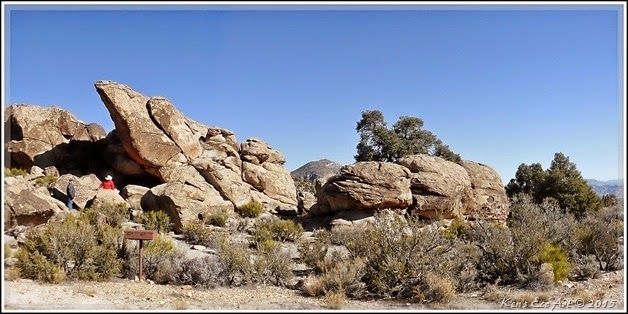 |
| (Fig. 01) |
|
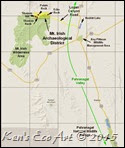 |
| (Fig. 02) |
Directions: Mt. Irish Rock Art and Archaeological District is located in the Pahranagat Valley (Fig. 02), about 110 miles north of Las Vegas. From Las Vegas, drive north on I-15 to US Highway 93. Turn left onto US Highway 93 and drive north past the towns of Alamo and Ash Springs to the intersection of Highways 93 and 318. The entrance and gate to Mount Irish Rock Art Site is 3.9 miles from the intersection of State Route 375, State Route 318 and U.S. Route 93 (the “Y”). Traveling north on State Route 318, towards Ely, it is on the left (west) side of the road just past Key Pittman Management Area. A yellow BLM marker is just to the left of the gate. Go through the gate, and continue approximately 12.0 miles, about a quarter mile past Paiute Rock, to Shaman Knob, the final petroglyph area in the District (Fig. 03).
|
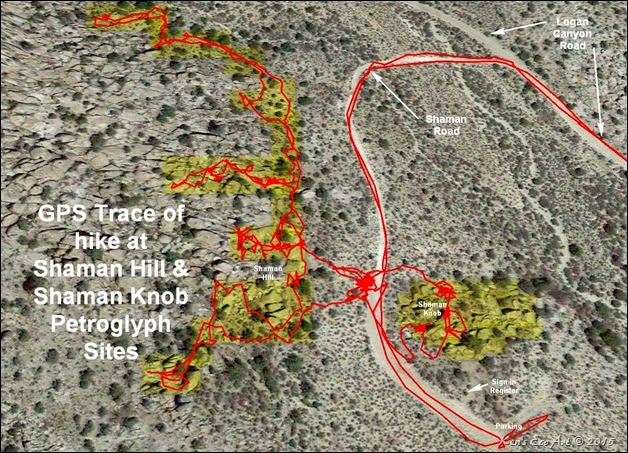 |
| (Fig 03) |
|
01/21/2015 Trip Notes: Shaman Knob is one of the major public petroglyph sites in the district and consists of a large, isolated boulder pile. The BLM placed four numbered markers around the site, and both the BLM and Lincoln County produced brochures describing the numbered rock art panels.
Looking due north from the sign-in register, there are three patterned body anthropomorphs and a
Pahranagat figure to their left, high up on the south facing rock face (Figs. 04 & 05). These are so high up it makes you wonder how someone was even able to etch them. Turning and walking to the right you enter kind of a natural passageway (Fig. 06). Looking up to the panel on your left, along with some patterned body anthropomorphs, there is a solid body anthropomorph with horns (Fig. 07). Continuing on the next rock panel (Fig. 08) has an extremely large Pahranagat Man about four feet above the ground. The well defined image is nearly two feet tall (Fig. 09). I don’t know why his arms and legs appear to be much lighter in color. The only thing I can think of is that someone may have ‘chalked’ the image, a definite no-no, to make it stand out better. The major last panel in this area contains several ‘stick figure’ anthropomorphs and a zoomorph that almost looks like a cow vs a sheep (Fig. 10). As you can see from (Figs. 11 & 12), the top of this rock has a large looking tinaja that was probably used for collecting rainfall.
Unique to the Pahranagat Valley is the anthropomorph called the “Pahranagat Man” or “P-Man.” Some of the Pahranagat figures are curvilinear, and some are rectilinear in form. The spatial placement of this Pahranagat figure may be representative of a “power being” of perhaps spiritual or supernatural nature. Many of the Pahranagat figures have “attendants” or “protectors” (Swartz & Hurlbutt 1994: 20). When walking around Shaman Knob and Shaman Hill area, note the positioning of the large Pahranagat figures. Study of the Shaman Knob area suggests that it was a major center of activity of repeated camping by hunter-gatherers over thousand of years (Fawcett 1993:5, Swartz & Hurlbutt 1994:13). There seems to be a close relationship between the system of religious beliefs and rituals, and the rock art and landscape (Fawcett 1993:5, Swartz & Hurlbutt 1994: 13). Scroll to the bottom of this page for more information on the ancient peoples that created these petroglyphs. |
|
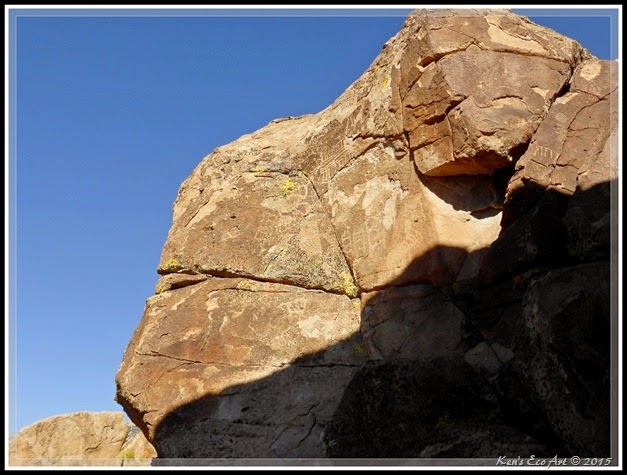 |
| (Fig. 04) |
|
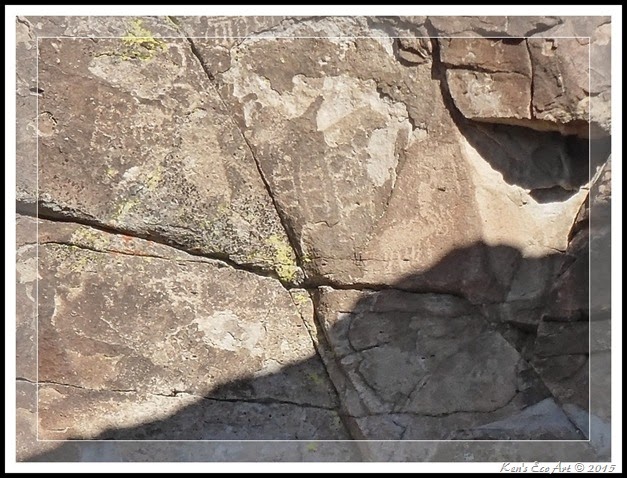 |
| (Fig. 05) |
|
|
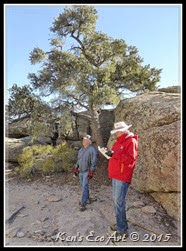 |
| (Fig. 06) |
|
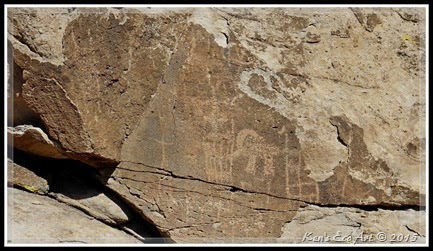 |
| (Fig. 07) |
|
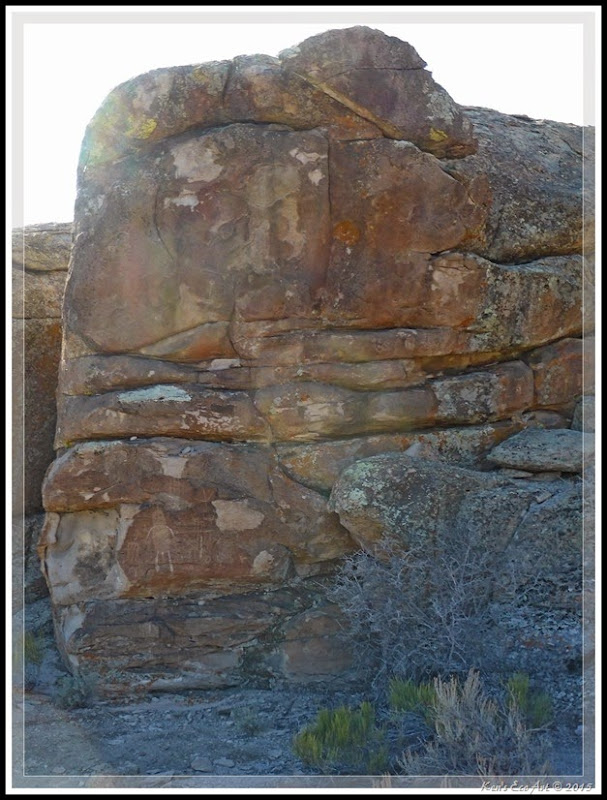 |
| (Fig. 08) |
|
 |
| (Fig. 09) |
|
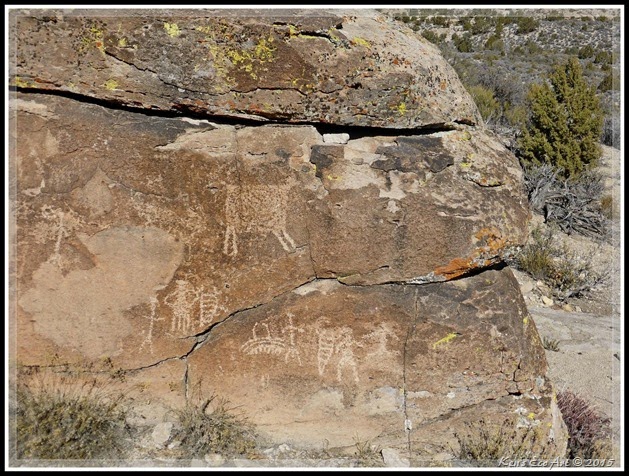 |
| (Fig. 10) |
|
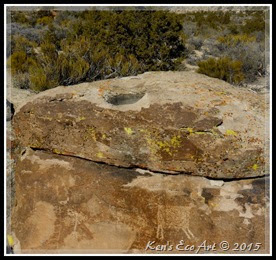 |
| (Fig. 11) |
|
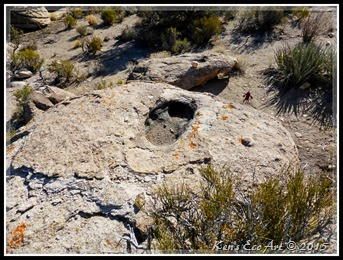 |
| (Fig. 12) |
|
Site History: It is believed that today's Paiutes and Shoshones are direct descendants of the last hunter-gathers in southern Nevada. Peoples who, during the past several thousand years, were experts in living in an arid environment. Roaming on a seasonal basis in search of natural resources (water, plants and seeds) and game (bighorn sheep and deer), they lived in caves and brush structures in small open camps. Petroglyphs, as well as other archaeological finds, suggest that these sites were occupied from around 1000 B.C. to the 1860's.
The rock art found in the hills surrounding the Pahranagat Valley are representative of the three different cultures and have been classified with three distinct styles: The Great Basin Abstract Style, that is predominately abstract symbols (circles, grids, etc,); the Pahranagat Representational Style (bighorn sheep, deer and anthromorphs – human-like characters with rectangular bodies and solidly pecked out bodies and heads); and the Fremont Representational Style, that resembles the classic trapezoidal bodied Anthromorphs and Quadrapeds.
It is believed that various distinctive cultures, known today as the Desert Archaic, Fremont, and Southern Paiute, visited these areas. By AD 1300, the Fremont had disappeared from the archaeological record of Southern Nevada, perhaps as a result of long-term droughts or other, as yet, unknown factors. Most of the petroglyphs have been classified as the "Great Basin Representational" style (A.D. 1-1500). In general, the Pahranagat Valley was a winter site for a group of peoples known as the "Pahranagats", one of several Southern Paiute groups. In recent years, archaeological evidence indicates that some Southwestern groups co-existed in this area along with the Pahranagats c. AD 500-1250. Evidence of the Pahranagats and their way of life can be found throughout Lincoln County's network of interrelated rock art sites including: Ash Springs, Crystal Wash, Mount Irish, Rainbow Canyon, Shooting Gallery and White River Narrows. Click the following link to learn more about Nevada Rock Art ...
Understanding Nevada Rock Art












